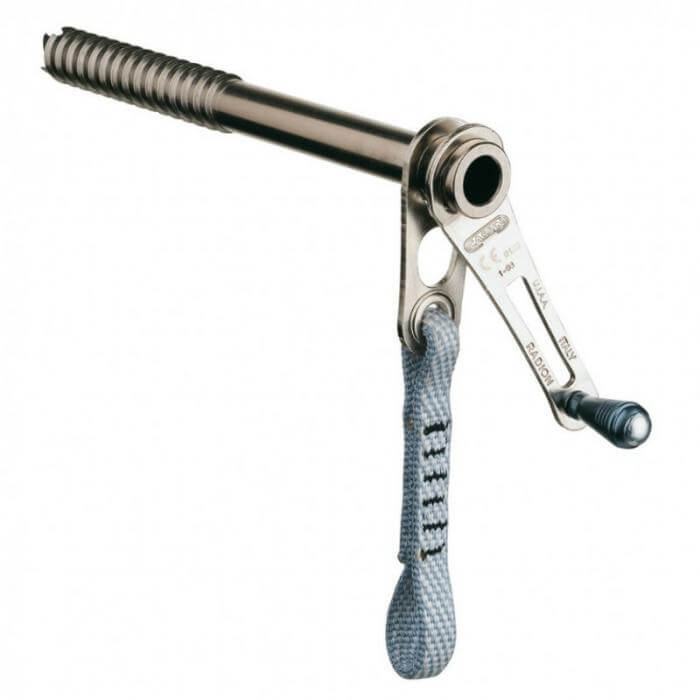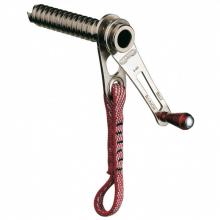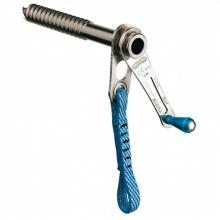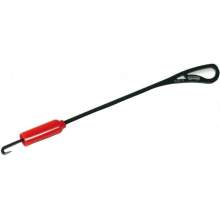Radion 22cm
Description
Can be clipped to the rope while placing to prevent accidental loss.
Machined with a shaft thickness tolerance of only 0.03 mm.
Front teeth are milled with three different angles for fastest penetration.
Reverse angle threads are optimized for brittle ice.
Angled lever arm provides clearance during placement.
Reduces total rack weight with the built-in sling.
Bright finish on hanger and lever helps reduce melt out in the sun.
Easy racking with two clipping points.
Includes tip protector and thread guard for packing.
The Radion is the most advanced ice screw available. A unique hanger rotates independently on the shaft, ensuring the force of a fall is applied at the optimal angle. The Radion features a reverse angle on the threads (flat side towards the ice), to distribute pressure more uniformly in brittle ice. Placing a Radion is greatly simplified by the aggressive front teeth, an ultra-smooth shaft, and a stiff lever arm with a rotating knob. The color-coded Dyneema sling saves the weight and hassle of an extra draw. With a carabiner pre-attached you can be moving upwards faster than ever. The screw can be placed or removed while clipped to the rope ensuring it will never get dropped. A carabiner hole on the steel hanger gives a second option for racking.
Retail price
This Product is Hard to Find.
We don’t know where you can buy this item online in the US. We’ll continue to check all the major retailers and will update this page as soon as we find one.
If you know where to find this online in the US, let us know, and we’ll add the link.
Weight (grams / ounces)  Weight (g / oz)In grams and ounces, the weight, as stated by the manufacturer / brand. | 199 g / 7.00 oz |
Length (cm)  Length (cm)Ice screws range between 6 - 30 cm. Generally speaking the sizes can be thought of as: Short - 13 cm and belowShort screws (“shorties” or “stubbies”) are for thin ice found on harder ice climbs and/or in crappy conditions. Medium - 14 - 17 cmWith ideal conditions climbers will be able to plug medium-sized screws with no problem. They have a nice weight to length balance. Long - 18 cm and aboveLong screws are most often used as anchors or in crappy ice conditions where they can go deep to find the real ice below. Mountaineers may also prefer long screws as they can gain better purchase in less than ideal ice and have less chance of melting out. How Many To CarryThere is no standard of how many screws to carry of each size. It will vary depending on where you’re climbing, your style of climbing and what level you’re climbing at. Some climbers will get a variety of the sizes, while others might get a majority of medium screws, a few shorties for thin spots and some long screws for anchors and bomber placements. Note: The amount of threading on each screw does not change even when the overall length changes (exception: e-climbs screws). |
22 cm |
Feature(s)  FeaturesNo Handle / KnobAbout 30% of the options 
Pros: Cheaper Cons: No “speed” handle/knob for faster threading Note: This is not currently a feature to filter on (coming soon), but is important to see the difference. Handle (non-fold)About 24% of the options 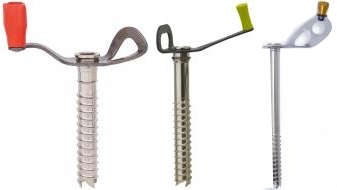
Pros: There is an extra “handle” or “knob” for faster screw threading. Cheaper than folding versions. Cons: Some of the knobs stick out substantially and could cause the rope or draws to get caught on the lengthened handle. Handle (folding)Around 42% of the options 
Pros: Foldable handle allows for quick threading and reduces snagging potential by folding out of the way. Cons: More expensive. Color CodingNearly 70% of the screws are color-coded, and this represents nearly all of the screws that have handles/knobs (color coding can also be on the hanger or the tube itself). 
Pros: Like on cams, color-coding makes for faster size identification. Cons: Generally color coding only comes on more expensive screws (with handles) There are 7 brands that follow red, yellow, blue, gray, green as a small to large standard, but that is not consistent across the industry. Sewn Sling (Pre-Attached to the Hanger)
Pro: You don’t have to carry quickdraws, so it saves weight and speed of clipping. Con: The length of this sling may not be ideal and it is not adjustable 2 Clip Points on the Hanger
Pro: More clipping options, especially ones that are closer to the ice to reduce leverage in a fall situation. Con: This comes standard on only a few screws so your options are limited. On some configurations this will also make the hanger much larger. Reverse Threading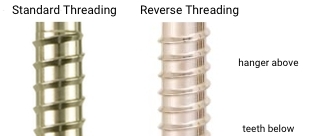
This is the most controversial feature. Grivel and CAMP (which make up 30% of the ice screw market) use reverse threading on all of their screws and claim that this angle is more effective at spreading an impact load across ice. If you are interested in the merits of the “reverse thread” design, click to see photos of the concrete tests (reverse threading pulls out more concrete than standard threading) and read about the concerns of testing in concrete. Read discussion of the engineering that goes into thread design and the questioning of straight pulls while testing to judge if reverse threading would make a [significant] difference in the event of a fall on ice. |
Handle (non-fold) Color Coding Sewn Sling Attached 2 Clip Points Reverse Threading |
Strength (kn)  Strength (kN)In kilonewtons, the strength as stated by the manufacturer / brand. |
10 kN |
Materials  MaterialsHangerThe material of the ice screw hanger (what you'd be clipping a carabiner into). Expect Stainless steel or aluminum here. TubeThe material of the tube of the ice screw (aka shaft). Most often it'll be Chromoly or steel but Grivel, Petzl and e-climb (and perhaps others) offer an aluminum tube ice screw option. Nearly 90% of ice screws are made from steel because steel is stronger and more durable. Aluminum screws will dull and wear out much faster and are not designed for crag-style ice climbing. They are specialty ice screws best used for fast and light ascents. TeethThe material of the teeth. Most often the tube material and the teeth material will be the same (e-climb and Petzl are exceptions). Often, screws with aluminum tubes will have steel teeth to help with durability. | Hanger: Chromoly Steel Tube: Chromoly Steel Teeth: Chromoly Steel |
Certification  CertificationsThe main climbing gear certifications are CE and UIAA--and normally the UIAA creates the rules that the CE body also supports. When possible, we try to list all the certifications the product carries. To sell a climbing product in Europe, the device must be CE certified. There are no official requirements to sell climbing gear in the US. The UIAA certification is a voluntary process. Ice screws are not certifiable below 10cm. Learn MoreRock and Ice Certifications Guide |
CE, EN |
No reviews yet.
One of the positive features of this design though was the fact that it can be clipped to the rope before it is wound in (or out), meaning that the screw won't be dropped. In use we found clipping screws to the rope before placing them to be impractical, but taking them out whilst they are still clipped to the rope (whilst you are seconding) did actually work a treat. So no dropped screws by your second anymore!
Summary: Decent screws with an interesting double unit on the head. Quite heavy for the size, but could be used just with a carabiner instead of a quickdraw, although we preferred not to. Awkward to clip. Interesting reverse thread design could increase holding power in brittle ice.
Because of these drawbacks and its high price, I would categorize the Radion as a go-to niche screw. Though Radions will never become the backbone of my rack, I also will never leave the ground without a few on an extra cold day.
Pros: Sharp teeth bite well in cold ice; solid, low-profile arm offers great crank leverage; unique thread design fractures less ice; floating hanger allows leader to clip into a partially placed screw.
Cons: Long crank arm gets caught up on textured ice; awkward racking; expensive.

